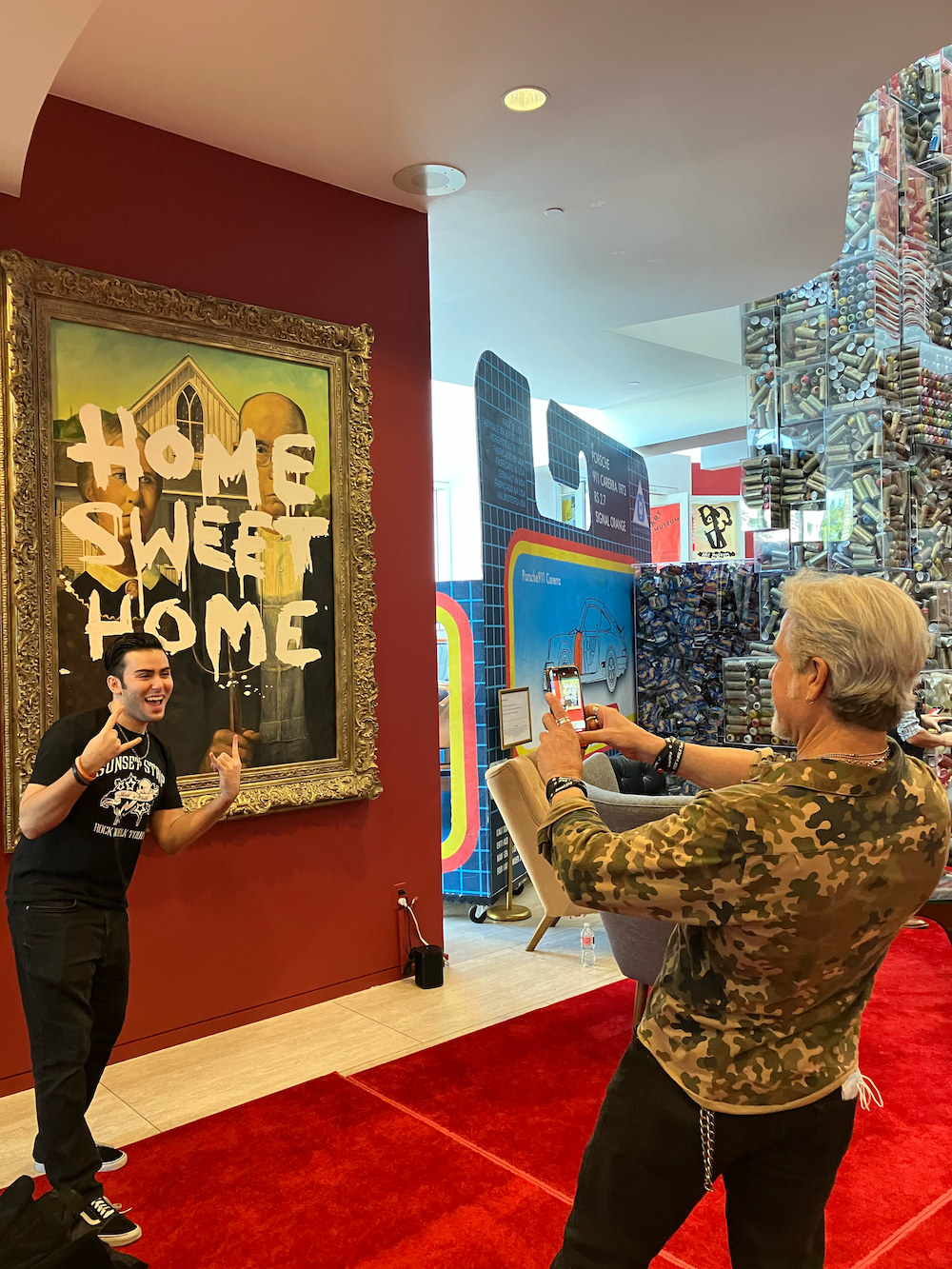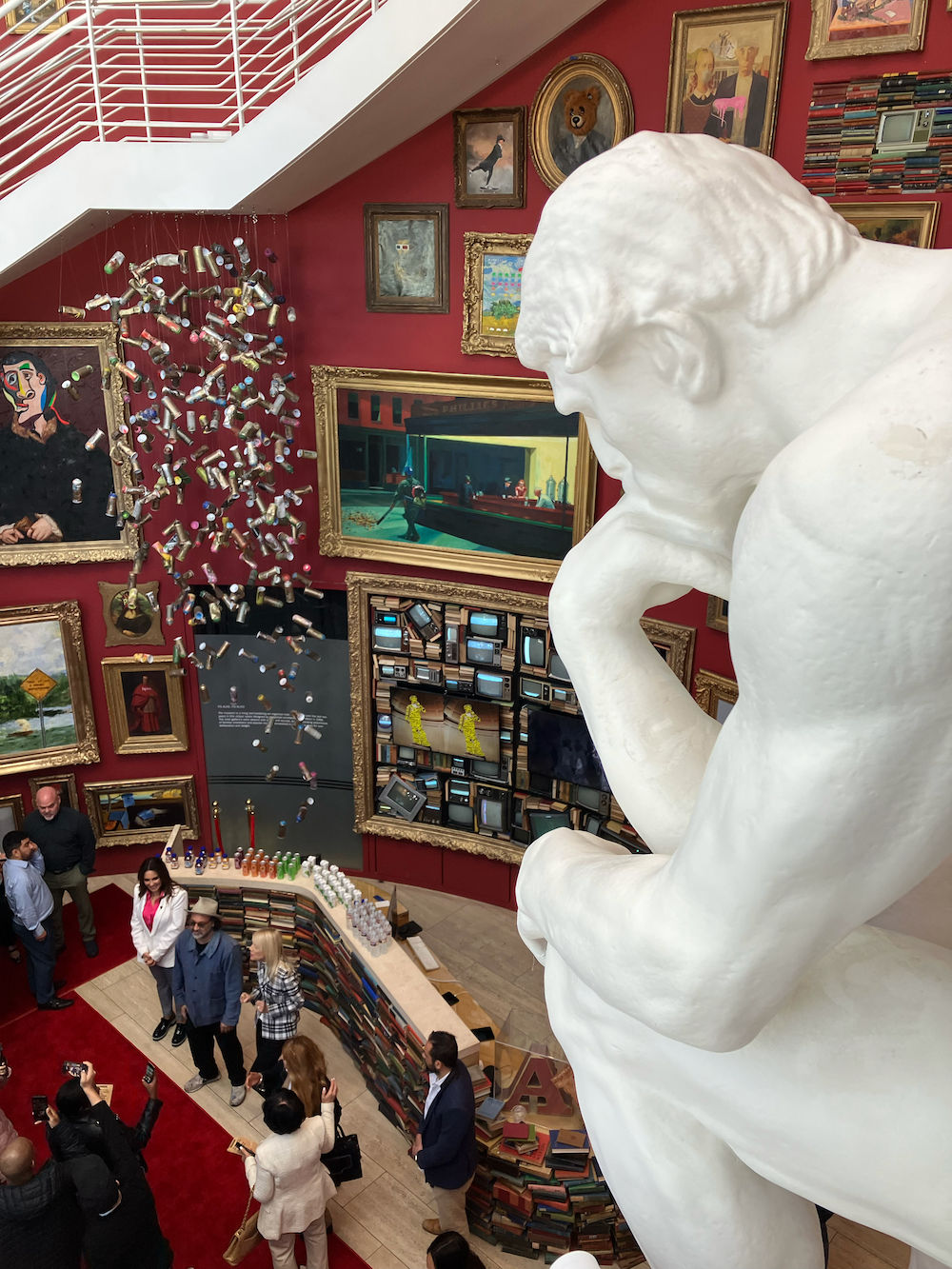The late-morning crowd lining up under the sports-car replicas on the wall of the old Paley Center was in a buzzy mood. Patiently waiting to gain access to the “Mr. Brainwash Museum” were an assortment of retirees, matrons and members of the spray-tanned classes—a boomer cohort that also seemed to feature several chamber-of-commerce types and devout fans of Beverly Hills mayor Lili Bosse. The “guided tour” of Mr. Brainwash’s pop-up museum which opened in December, was, after all, part of the mayor’s “Business with Bosse” program, designed to promote city businesses, while meet ‘n greeting constituents. And both hosting mayor and featured artist were indefatigable, greeting every group as patrons streamed in in groups of 20 and taking selfies with anyone who wanted one—that is every single person and staff, down to the firefighters assigned to the show.
Then again, most people seemed on a veritable joy ride of photo self-portraits taken in front of seemingly each of the exhibited works: Dali’s with melted iPads—click, Mona Lisa’s with clown noses—click, and so on down the line of repurposed Andy Warhols, pixelated van Goghs, tagged “American Gothics,” rejiggered Edward Hoppers and what one wall caption called “exploded archetypes of art history.”
Through it all Mr. Brainwash was a blur, rearranging the vitamin water, directing his video crew and yes—taking ever more selfies.
“Best modern art show I have seen ever!” a bejeweled woman chirped effusively.”
“Thank you we’re open on Sundays.”

Never enough selfies. Photo by Luca Celada.
Mr. Brainwash is the “street” moniker of Thierry Guetta, who vaulted to prominence in the 2007, Banksy-directed Exit Through the Gift Shop as a French street art enthusiast, clothing retailer and cousin to actual street artist, Invader. In the movie he’s the ostensible filmmaker who sets out with a camera to document the guerilla style art-making incursions of the artists he admires: Invader, Shepard Farey and Banksy. But halfway through, Banksy takes over and convinces Mr. Brainwash, to himself become the subject of the film which ends up documenting his debut show: 2007’s “Life Is Beautiful” exhibition in the old CBS studios building on Sunset.
The genius of that situationist mockumentary is how coyly it dances around the central question: is Mr. Brainwash an artist or does he just impersonate one? And is his copious remixing of prêt-a-porter irreverence art or a spoof? That is somewhat beside the point. In the intervening 15 years Mr. Brainwash has parlayed that beginning into a successful celebrity-adjacent career, by means of what his website calls “the orchestrated collision of street art and pop art”—although if one was in an uncharitable mood, one could also think of the collision between self-promotion and commerce.

Rodin looking down. Photo by Luca Celada.
And to this day, despite mounting daily evidence to the contrary, Guetta sticks to his original catch phrase. We personally asked him a few questions during a breather in the show action and his unswerving answer to most of them was: “Life is beautiful!”
At this point the legitimate question arises: Is the career in fact the actual art work? No matter the answer, it is safe to assume that monsieur Brainwash does not share his old mentor’s caustic outlook on capitalism.

Architectural rendering of new luxury complex in Beverly Hills.
Speaking of capitalism, the show may be the last to take place in the Richard Meier designed building on the corner of Beverly Drive and Little Santa Monica Boulevard. In fact, it could be the last event of any kind to happen there or in the adjacent building that used to be Brooks Brothers. In 2018 LVMH (the Louis Vuitton Moët Hennessy luxury brand conglomerate owned by richest-man-in-the-world Bernard Arnault) purchased the properties for $465 million and has filed plans to demolish them in order to build an “ultra-luxury” hotel spanning the entire block between Beverly and Rodeo drives. The Cheval Blanc would include about 100 suites (average price $2,045-a-night), recessed terraces, restaurant, a private club and multiple swimming pools plus “high-end retail” spaces.
The project was approved last June by the city’s planning commission. In September it received conditional approval from the city council which last November voted a final green light. Construction is slated to begin within a year and be completed by 2027 at a projected cost of $666 million.
In order to allow for the hotel’s size, the mayor and Councilmember Lester Friedman worked with LVMH and private lawyers. According to Beverly Hills’ Community Planning chief, Timmi Tway, the project “did not include variances, but did involve the adoption of a “specific plan,” which specified ad hoc zoning regulations for the site.” The plan allows for up to 220,950 square feet of built space up to a height of nine stories on the Rodeo Drive side, dwarfing what is common in the Beverly Hills “business triangle.” Furthermore, the city did not attach any affordable housing requirements to the Cheval Blanc, as is common practice when permitting developments, even though state planners have determined that Beverly Hills must build 3106 affordable units by 2029 as part of its Regional Housing Needs Assessment (RHNA). And that it is lagging: in a pointed letter last December, the State rejected its plan to develop the mandated units.

Architectural rendering of new luxury complex in Beverly Hills.
Nevertheless, city officials have gushed over the prospect of the tax bounty the project would pour into city coffers. Mayor Bosse praised the project as an “architecturally unique” and “visionary,” telling the Beverly Hills Courier that she considers it a “peek into the future,” and “everything I believe our community is about.” “I felt we were creating the next 100 years and the future,” the mayor was quoted, “for me, (the approval) was a monumental and exciting moment.” (We brought up the subject at the Mr. Brainwash show, but Bosse declined to comment, saying she was concentrated solely on the day’s event.)
The lone dissenting voice has been that of Beverly Hills Councilmember John Mirisch who has argued that the Paris-headquartered LVMH’s commitment to the city should include putting money toward affordable housing. “We are being fleeced,” Mirisch said, noting that the development would be the only such property with a prestigious Rodeo Drive address. “They hired ex-mayors and commissioners as consultants—it’s money greasing the way.” Mirisch had pushed for raising the occupancy tax by 4% on the Cheval Blanc as a way of subsidizing affordable units in the city, a measure that was rejected.
But his colleagues’ position is summarized by Vice-Mayor Julian Gold’s statement to the Courier: “We’re very fortunate to live in this luxury environment. This luxury environment actually creates the sense of home that Councilmember Mirisch pines for. And, at the same time, it provides the safety—the fire and police—and all the other amenities that we have.”
Beyond the optics of doubling down on ultra-luxury without affordable requirements in a time of unprecedented wealth concentration and in a metro area with a declared homeless state of emergency, the planned demolition of the ex-Paley building raises the question of aesthetics and architectural heritage. The modern landmark was built by Meier in 1996 for the Paley Center for Media, in the style of the Getty Center (also by Meier), which would open a year later. It would be replaced by a building of what renderings show to be average banality, another entry in the performative luxury kitsch (sorry, “ultra-luxury”) of the Beverly Hills commercial district, where tourists flock to take selfies in front of expensive automobiles and branded stores.

Architectural rendering of new luxury complex in Beverly Hills.
The operation would qualify as an egregious instance of urban erasure in a region that never met a real estate deal that wouldn’t trump urban heritage or cultural infrastructure. In this case it will involve bulldozing an existing museum space and replacing it with a private commercial development, rather than repurposing it for art or alternative exhibition purposes. Another instance of favoring private interests over public and cultural priorities in the age oligarchy.
“If they had offered to include something of cultural value, like a museum, we certainly would have explored that,” added Mirisch who noted the vast art collection held by the Fondation Louis Vuitton affiliated with LVMH. Ironically the Foundation engaged the services of LA-based Frank H Gehry to build its own museum in Paris’ Bois de Boulogne. Five years ago LVMH created a pop-up museum of its own in the ex-Brooks Brothers building, showcasing the art of Louis Vuitton.
In making his presentation to the Council, the architect of the proposed Cheval Blanc building, Peter Marino (specializing on decorative opulence in luxury boutiques and restaurants), said that the new building would be clad with the kind of French limestone “favored by (kings) Louis XI, XIV an XV.” He was also quoted explaining that the hotel lobby would feature “publicly visible art,” including a Sol LeWitt mural, so that “even if you can’t afford a room, you can enjoy all the artwork.” Calling forth visions not only of Louis’ limestone, but of Marie Antoinette’s brioches.
Compared to the craven forces of commerce clearly arrayed around this latest bit urban plutocracy, Mr. Brainwash is looking like a regular Mother Theresa.
The last word on the matter may not yet have been spoken. In January two last-minute petitions were presented and certified by the city clerk, asking the city Council to either rescind the project approval or force a ballot measure allowing citizen to have their say on the building.


